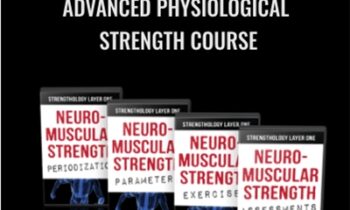$199.00 Original price was: $199.00.$59.00Current price is: $59.00.
Digital Download: You will receive a download link via your order email
Save up to 85% compared to Salepage prices. In addition, earn additional points. Save more on your next order.
Please contact email: wixzip.cs@gmail.com if you have any questions about this course.
 Purchase this course you will earn 59 Points worth of $5.90
Purchase this course you will earn 59 Points worth of $5.90Elevate your skills with the Pam Collins, Robin Gilbert – Prevent a Patient Crisis Simulation Lab Scenarios & Critical Skills to Update Your Practice course, available for just $199.00 Original price was: $199.00.$59.00Current price is: $59.00. on Utralist.com! Browse our curated selection of over 60,000 downloadable digital courses across diverse Health and Medical. Benefit from expert-led, self-paced instruction and save over 80%. Start learning smarter today!
 Pam Collins, Robin Gilbert – Prevent a Patient Crisis Simulation Lab Scenarios & Critical Skills to Update Your Practice
Pam Collins, Robin Gilbert – Prevent a Patient Crisis Simulation Lab Scenarios & Critical Skills to Update Your Practice
Ideally, your job isn’t to run a good code…but to prevent the code from ever happening. The early warning signs are key — know them, notice them, and interpret them within the whole clinical picture, then act appropriately and confidently.
Are you afraid you’ll miss subtle but crucial clues?
This online course will walk you step by step through the skills you need — from good communication to advanced critical thinking, and everything in between.
In addition to the invaluable simulation videos, you’ll get two engaging, high-energy presentations on patient crisis and emergencies. Walk away with advanced knowledge, tools, strategies, and interventions that will transform your practice — and ultimately help you save lives.
- The dangers of being too task-oriented
- How to stay out of court, and how to protect yourself if you do end up there
- Documentation samples — examples of good and poor documentation
- How to get your busy coworkers to weigh in on your patient’s condition
- The earliest sign of trouble may not be what you think
- Strategies to differentiate the complaint of abdominal pain
- Tips to interpret EKG findings — don’t miss life-threatening changes
- 3 easy steps for ABG interpretation (yes, really!)
- A unique assessment tool to detect hypocalcemia — before seizures and respiratory stress set in
- …and so much more!
Today’s nurses care for more patients with higher acuity than ever before. Know who is at risk, recognize the warning signs, and prevent a crisis before it happens. The vital difference in effective nursing is in the ability to “see it coming.” Return to your practice more prepared than ever to identify and manage — and even prevent — the next patient emergency!
Here’s what you’ll learn in this comprehensive online course:
Session 1
Critical Skills for Managing a Patient in Crisis
- Tools to Sharpen Your Crisis Management Strategies
- 6 Fail-Proof Steps to Rhythm Interpretation
- Critical Actions for “I’m Having Chest Pain!”
- Abdominal Pain: What is it REALLY Telling You?
You have a daunting challenge of recognizing subtle changes in a patient’s condition that can lead to a medical emergency. Do you know what to do for the older woman who suddenly doesn’t know her name or the joint replacement patient who suddenly complains of chest pain? These are scary situations, but you don’t have to panic! Pam Collins, MSN, CMSRN, RN-BC, will share clinical insights to sharpen your skills in identification and management for a wide variety of bedside nursing emergencies, including: neurological, cardiac and GI emergencies.
Session 2
Key Interventions & Documentation Strategies During a Patient Emergency
- Prevention, Presentation and Action for the Most Common Nursing Emergencies
- ABG Analysis Made Easy
- Respiratory Emergencies: Quick Assessment Strategies for Rapid Action
- Documenting High Risk Situations
Expert speaker, Pam Collins, MSN, CMSRN, RN-BC, will help you get the best tools and strategies for early identification and management of emergencies such as pneumonia, pulmonary embolism, and respiratory failure, as well as the variety of post-op complications that can present. Leave this online training more prepared than ever to identify and manage your next patient emergency!
Session 3
Robin Gilbert, MSN, RN, CEN, CPEN, will use simulation scenarios to identify patients whose condition is deteriorating, the appropriate interventions, and desired outcomes. Simulation provides a non-threatening approach to high-risk scenarios that will ultimately improve patient safety. The realism of simulation can improve failure to rescue situations in actual patient care. During the scenarios, the mannequins will respond based on the interventions delivered for a variety of high-risk situations, including:
- Pulmonary Embolism
- Shock
- Sepsis
- Respiratory Crisis
- Acute Change in LOC
Viewing these simulations will allow you to think through the action you might plan to take for the patient and further reflect on her best practice recommendations and rationale that follow. Virtual simulation is self-paced to allow for personal assessment of strengths and weaknesses. Learning through simulation scenarios provides immediate feedback in a safe environment, which builds confidence and provides an excellent bridge to real-life patient care situations.
About the Speakers:

Pam Collins has more than 30 years of extensive nursing experience, which includes work as a staff/charge nurse for medical-surgical and pediatric units, nurse manager/nursing administration, nursing faculty and Education/Medical/Legal Consultant. She has extensive experience with the Legal aspects of Nursing Practice/documentation to include providing litigation support in medical malpractice. Pam speaks nationally on clinical and legal topics for the healthcare professional with a passion that is evident through her energy, presentation style and ability to engage the audience. She was previously awarded the Outstanding Educator of the Year Award by the South Carolina Area Health Education Consortium.

Robin Gilbert has over 25 years’ experience in emergency nursing. She is both a certified emergency nurse and certified pediatric emergency nurse. Robin has experience as an emergency department manager, manager of cardiac & pulmonary rehabilitation and, currently, as the regional manager for staff development at Central Maine Medical Center. She instructs the NCLEX review class for Kaplan and tutors nursing students online for a local college of nursing. Her experience also includes having been an item writer for the Board Certification of Emergency Nursing and a former Chairperson.
Sale Page: https://catalog.pesi.com/sales/hc_001163_preventcrisissimlab_organic-11305
Archive: https://archive.fo/RZynD
Delivery Method
Be the first to review “Pam Collins, Robin Gilbert – Prevent a Patient Crisis Simulation Lab Scenarios & Critical Skills to Update Your Practice” Cancel reply
Cultivate continuous growth with the Pam Collins, Robin Gilbert – Prevent a Patient Crisis Simulation Lab Scenarios & Critical Skills to Update Your Practice course at Utralist.com! Unlock lifetime access to premium digital content, meticulously designed for both career advancement and personal enrichment.
- Lifetime Access: Enjoy limitless access to your purchased courses.
- Exceptional Value: Benefit from savings up to 80% on high-quality courses.
- Secure Transactions: Your payments are always safe and protected.
- Practical Application: Gain real-world skills applicable to your goals.
- Instant Accessibility: Begin your learning journey immediately after buying.
- Device Compatible: Access your courses seamlessly on any device.
Transform your potential with Utralist.com!
Related products
Health and Medical
= 43 Points
Health and Medical
= 35 Points
Health and Medical
CDT Dental Coding and Reimbursement Update: Identifying Common Practice Mistakes – Paul Bornstein
= 85 Points
Health and Medical
= 43 Points
Health and Medical
= 85 Points
Health and Medical
= 29 Points
Health and Medical
= 27 Points
Health and Medical
= 33 Points




 Pam Collins, Robin Gilbert – Prevent a Patient Crisis Simulation Lab Scenarios & Critical Skills to Update Your Practice
Pam Collins, Robin Gilbert – Prevent a Patient Crisis Simulation Lab Scenarios & Critical Skills to Update Your Practice






Reviews
There are no reviews yet.